
STANLEY ROSEMAN
STILL LIFES
"With a seriousness that pushes him always further in treating a subject or theme, he continually clarifies and refines, never letting his interest waiver or diminish.''
- Bibliothèque Nationale de France
Les Pommes sauvages, 1978
Oil on canvas, 18 x 18 cm
Musée Ingres, Montauban
Oil on canvas, 18 x 18 cm
Musée Ingres, Montauban
4. Les Pommes sauvages, 1978
Oil on canvas, 18 x 18 cm
Musée Ingres, Montauban
Oil on canvas, 18 x 18 cm
Musée Ingres, Montauban
Living in France, where still lifes are an important subject in art, Roseman resumed painting still lifes. Apples were again one of the artist's choice of subject matter.
Still Lifes in France
5. Apples on a White Tablecloth, 2007
Oil on canvas, 41 x 33 cm
Collection Ronald Davis
Oil on canvas, 41 x 33 cm
Collection Ronald Davis
7. Pears on a Green Tablecloth, 2007
Oil on canvas, 30 x 30 cm
Private collection, London
Oil on canvas, 30 x 30 cm
Private collection, London
6. Clementines, 2005
Oil on canvas, 27 x 41 cm
Private collection, Pennsylvania
Oil on canvas, 27 x 41 cm
Private collection, Pennsylvania
9. Still Life with Shrimps and Sea Snails, 2006
Oil on canvas, 27 x 34 cm
Private collection, Michigan
Oil on canvas, 27 x 34 cm
Private collection, Michigan
The shrimps and sea snails are arranged on a sheet of wrapping paper from the fish shop, the off-white crinkly sheet dramatically set against a dark background.
Musée Ingres.
Pears are a recurring subject in the artist's still lifes, as seen in the work Pears on a Green Tablecloth, 2007, presented below, (fig. 7).
© Stanley Roseman and Ronald Davis - All Rights Reserved
Visual imagery and website content may not be reproduced in any form whatsoever.
Visual imagery and website content may not be reproduced in any form whatsoever.
Apples on a White Tablecloth, 2007, (fig. 5), is an impressive still life depicting six red apples lying on a white linen tablecloth with folds with silvery to dark gray shadows. The apples with swirls or patches of green pigmentation on luminous red skin are placed high in the composition, counterbalanced by the length of the tablecloth that descends over the edge of the table and occupies the lower half of the picture.
The triangular arrangement of the three apples placed in the center of the composition is repeated in the combined grouping of the six apples. The recurring element of the triangle is seen in the folds of the tablecloth. Roseman's mise en page brings together a harmony of geometrical shapes and forms in the depiction of the familiar objects in pictorial space.
Still lifes are a recurring subject in Roseman's oeuvre, which comprises a diversity of subjects in a variety of mediums. The Bibliothèque Nationale de France in a biographical essay on the artist in its exhibition publication Stanley Roseman - Dessins sur la Danse à l'Opéra de Paris (Paris, 1996, text in French and English) praises Roseman for his "innate artistic talent, expressed through a wide range of techniques" and further states, as quoted above: "With a seriousness that pushes him always further in treating a subject or theme, he continually clarifies and refines, never letting his interest waiver or diminish.''[1]
2. Lemons and Lime, 1975
Oil on canvas, 24 x 30 cm
Private collection
Oil on canvas, 24 x 30 cm
Private collection
3. Cartier, Fifth Avenue, window display, 1976,
with Stanley Roseman's still life
Lemons and Lime.
with Stanley Roseman's still life
Lemons and Lime.
Lemons and Lime, 1975, (Private collection), reproduced below, (fig. 2), with its dramatic composition and luminous colors was one of two Roseman still lifes that appeared in Cartier's two Fifth Avenue windows in 1976. The lemon halves, freshly sliced and glistening, lying next to the single lime form a group counterbalanced by the brightly illuminated, golden lemon in the foreground. The dark background deepens the spacial dimension in this beautiful painting.
Cartier - Fifth Avenue
Cartier had exhibited the year before in its Fifth Avenue windows stunning displays of the company's jewelry and two life-size portraits by Roseman. (See web page "Biography'' - Page 7 "Portraits.'') In 1980, Roseman returned to New York City from Europe, where during the first two years of his work on the monastic life, he also painted a series of Dutch landscapes with windmills. Raymond Mastrobuoni again designed marvelous window displays with Roseman's paintings and Cartier jewelry.
The Curator of the Musée Ingres, Pierre Barousse, in making his first acquisition, in 1986, from Roseman's oeuvre on the monastic life, selected "the beautiful drawing'' A Carthusian Monk at Vigils, 1982, Chartreuse de la Valsainte, Switzerland, that depicts an elderly, bearded monk who is also the subject of the artist's related drawing in the Ashmolean Museum, Oxford. Monsieur Barousse acquired in 1987 the painting Father Ian, Portrait of a Trappist Monk in Meditation, 1978, Mount St. Bernard Abbey, England, - "a work absolutely engaging,'' writes the distinguished Curator in further correspondence with Ronald Davis, who introduced the artist's work to the Museum.
Still Lifes with Fish
In the life of an artist, the enthusiasm of collectors is very meaningful. Roseman writes in his journal, "I am deeply thankful for the appreciation for my work that I have received over the years from my collectors, to whom I express my heartfelt gratitude."
Roseman painted a series of still lifes of clementines, the small seedless fruit considered a hybrid of the Seville orange and Chinese mandarin. The artist selected clementines from Spain, a major producer of the popular citrus fruit. With his admiration for the paintings of Velázquez, Roseman painted his still lifes with a Spanish palette of umbers, siennas, and greens complemented by the orange color of the fruit, as with the work presented below, Clementines, 2005, (fig. 6).
In this eloquent still life, six clementines lie on a dark, brown wooden table. Their slender leaves in nuanced shades of green fall gracefully around the small, orange spheres and rhythmically carry the viewer's eye over the composition with its interplay of highlights and shadows.
Taking up the square format of Les Pommes sauvages in the Musée Ingres, Roseman introduces a dominant green chromatic element to the still life of six Comice pears, whose formal name Doyenné du Comice indicates the pear's French origin. Within the square format of the composition, the delicious dessert pears are placed in a circle on a green tablecloth that fills the picture plane.
Monsieur Barousse asked Davis if Roseman had painted still lifes as still lifes are an important subject in French art. In seeing the present work, the Curator of the Musée Ingres acquired the "very beautiful still life'' and gave the painting its French title Les Pommes sauvages.
Three small, wild apples in luminous reds, greens, and golden yellows rest on a mahogany table. Roseman applied swirls of creamy paint with a freedom of brushwork in rendering the colorful spherical forms of the apples. The oil on canvas still life with its rich tonal harmonies and painterly textures is exemplary of the artist's use of the medium.
In keeping with the actual size of the apples in nature, Roseman has created an intimate still life with a dramatic interplay of lights and shadows as the pommes sauvages emerge from a dark background into the glow of a warm illumination.
Page 10 - Still Lifes
Biography: Page 10
8. Champignons de Paris, 2005
Oil on canvas, 20 x 40 cm
Private collection, Switzerland
Oil on canvas, 20 x 40 cm
Private collection, Switzerland
Cartier thoughtfully included in its window displays notices that read "Paintings by Stanley Roseman.''
In further correspondence from the collector Richard B. and his lovely wife Mary: "The painting of Shrimps and Sea Snails has arrived in excellent condition and has been hung with its compatriots in a place of honor over the sideboard in the dining room. It is a marvelous array and a feast for the eyes!"
Roseman's still lifes include the subject of fish, a series that he painted in France, where artists including Chardin, Delacroix, Courbet, Manet, Renoir, Gauguin, Van Gogh, Picasso, and Braque painted still lifes with fish. A variety of seafood is depicted, such as the gashed ray that hangs on a hook in Chardin's well-known still life entitled La Raie, c.1725-26, (Paris, Louvre); a trout that is the singular object in Courbet's La Truite, 1873, (Paris, Musée d'Orsay); red mullet in Gauguin's Still Life with Red Mullet and Jug, 1876, (Sweden, Göteborgs Konstmuseum); and a plate of oysters next to a pitcher and table napkin in a late still life by Braque, c.1954-57, (Private collection).
Salmon, conger eel, gray mullet, and oysters are among Manet's choice of fish for a number of impressive still lifes. Manet's high regard for the still lifes of Chardin is generally known as was the influence on Manet of Spanish painters of the Golden Age of Spanish art, such as Goya, who painted a series of still lifes around 1802-1812 that includes still lifes of fish.
In Western art, an early depiction of fish as a subject unto itself is Dürer's A Lobster, a remarkable pen and ink drawing signed with the artist's monogram and dated 1495 (Berlin-Dahlem, Staatliche Museen Preussischer Kulturbesitz, Kupferstichkabinett). Dürer scholar Peter Strieder states that the depiction of the lobster is "the earliest of Dürer's nature studies drawn from life''[3]
In a cordial letter to the artist, Richard B., a longtime collector of Roseman's work, writes: "We are enthralled with the paintings which are now hung side by side over the sideboard in the dining room. They leave an empty space, however, for another small, marvelous painting from this series, to flank the larger Sea Bass painting. We think this would be nicely filled by the 'Shrimps and Sea Snails' painting. (Mary especially insists.)"
The artist writes in his journal: "I learned that the French botanist Joseph Pitton de Tournefort (1656-1708), a pioneer of plant classification, made an early description of the cultivated mushroom Agaricus bisporus, known by its French name Champignon de Paris, whose whiteness and delicate flavor has contributed to the mushroom's popularity in fine cuisine.''
In contrast to Roseman's still lifes of fruit and vegetables with intensity of color is the painting Champignons de Paris, 2005, (fig. 8), in harmonious tones of whites, light ochre, grays, and browns. The mushrooms are arranged singly, in pairs, and in a group of three on a mahogany table in this striking composition with its circular leitmotif.
With strong chiaroscuro modeling of the mushrooms, which cast long shadows on the table, and detail rendering of form and texture with brilliant white highlights on the tender flesh, Roseman has created a superb still life of this culinary delicacy.
The golden-green color of the six pears is complemented by passages of viridian, sienna, and russet hues. The shading on the pears is tinged with blue, which is repeated in the long shadows on the green tablecloth.
Roseman's still lifes generally depict a few objects in a compact composition, a characteristic of still lifes by Chardin and Manet[2], for whose still lifes Roseman has a high regard. The series of still lifes that Roseman began in Paris in the 1990's and resumed as he continued painting still lifes in France include champignons de Paris, a subtly-flavored, pleasing ingredient in French cooking.
Champignons de Paris and a complementary still life Lemons and Limes, 2013, a stunning work depicting an arrangement of the citrus fruit on a light beige tablecloth, were acquired for a private collection in Switzerland. The artist brought the paintings to his collectors' home in Canton Bern and recounts: "I was very touched by the warm welcome and gracious hospitality of James and Patricia and their thoughtfully saying how very much they were looking forward to having the still lifes. In my presenting the work, James and Patricia expressed great enthusiasm for the paintings. That was a memorable occasion, and I am always very happy and sincerely thankful for the appreciation of my work.''
Roseman's still lifes of fish include sea bream; rockfish; red mullet; whiting; mackerel, with its dark tabby markings; and oysters on the half shell. Sea Bass, 2006, depicts two ocean fish with black and silvery-white skin coloration accented by red gills and fins. The impressive still life was acquired with a beautiful, intimate canvas entitled Sea Snails, 2006, for a private collection in Michigan.
Presented here is the splendid Still Life with Shrimps and Sea Snails, 2006, (fig. 9), from the Michigan private collection mentioned above.
Roseman composed a leitmotif of curvilinear, pictorial elements with the fascinating spiral forms of the sea snails in tones of green and greenish-gold; the crescent shapes of the pinkish-orange shrimps; and the shrimps' long antennae that twist and turn with fine, red-orange calligraphic strokes of the brush. The leitmotif of curved lines, shapes, and forms is complemented by the edge of the wrapping paper which rises like a great wave in this beautifully rendered marine still life.
1. Stanley Roseman - Dessins sur la Danse à l'Opéra de Paris (text in French and English),
(Paris: Bibliothèque Nationale de France, 1996), p. 11.
2. Hélène Prigent and Pierre Rosenberg, Chardin, An Intimate Art, (London: Thames & Hudson, 2000), pp. 77, 83.
3. Peter Strieder, Albrecht Dürer, (Abaris Books: New York, 1982) p. 198.
(Paris: Bibliothèque Nationale de France, 1996), p. 11.
2. Hélène Prigent and Pierre Rosenberg, Chardin, An Intimate Art, (London: Thames & Hudson, 2000), pp. 77, 83.
3. Peter Strieder, Albrecht Dürer, (Abaris Books: New York, 1982) p. 198.
Roseman writes in his journal: "I am very grateful to Raymond Mastrobuoni for his enthusiasm for my work, for it was truly wonderful to see my paintings so beautifully presented in the windows of Cartier.''
Roseman's sensibility for the great French tradition of still lifes is evident in his beautiful Les Pommes sauvages, 1978, in the collection of the Musée Ingres, Montauban. The Museum houses an important bequest from the French master Jean-Auguste-Dominique Ingres (1780-1867). Les Pommes sauvages, reproduced above, is from Roseman's series of still lifes painted during his years in New York City in the 1970's.
Roseman's still lifes, greatly appreciated by collectors, also attracted the attention of the international French jewelers Cartier, which requested to present the artist's still lifes in its Fifth Avenue windows.
The black and white photograph, (fig. 3), records the elegant, intimate window display designed by Raymond Mastrobuoni, Cartier's distinguished Associate Vice President of Visual Merchandising and a leading window designer who created innovative and captivating window displays that set high standards for visual merchandising and were noteworthy events for forty years on Fifth Avenue, New York City's world-famous shopping thoroughfare. In the present display, the lemons and lime in the Roseman still life have been imaginatively transposed from pictorial space into three-dimensional space. The triangular arrangement of objects in the painting is restated by the pyramidal grouping of citrus fruit with the presentation of exquisite pieces of Cartier jewelry. Cartier thoughtfully included notices that read "Paintings by Stanley Roseman.''
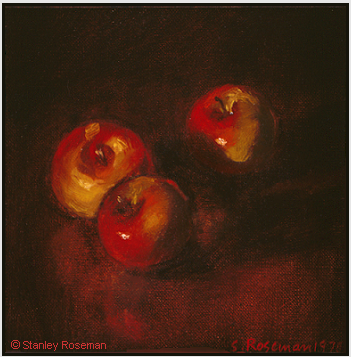
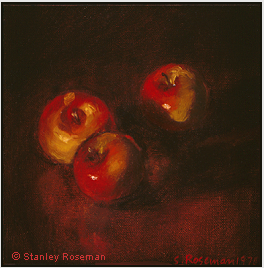
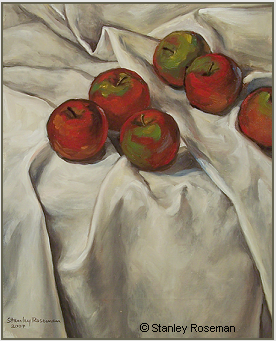
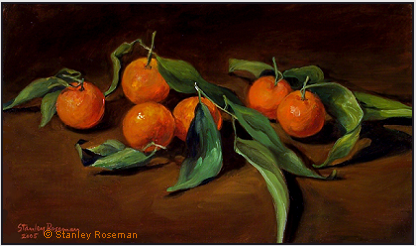
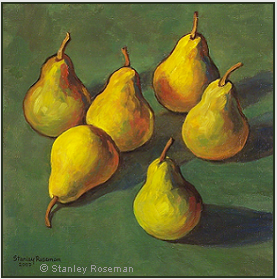
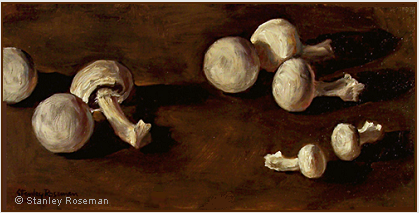
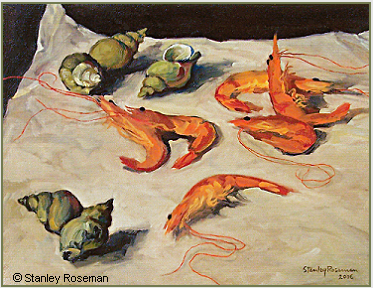
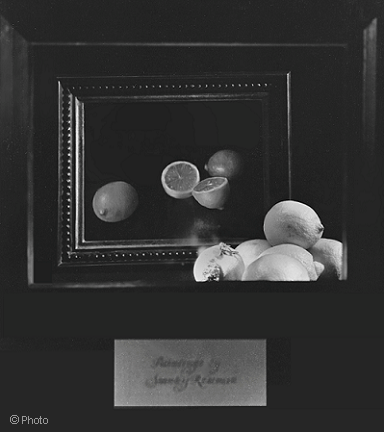
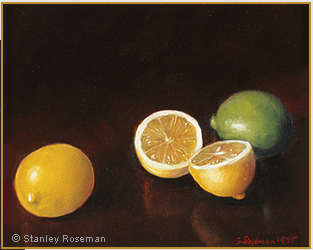
The important bequest from Ingres to his hometown of Montauban includes the French master's paintings and drawings, as well as notable works from his collection of the Italian School of the 15th and 16th centuries and the French School of the 17th, 18th, and 19th centuries. The Museum also conserves the work of the sculptor Emile Antoine Bourdelle, born in Montauban in 1861. The Museum's paintings and drawings from the 19th and 20th centuries include beautiful still lifes by Eugene Delacroix; Thomas Couture, who was Manet's teacher; and François Bonvin, a leading exponent of the Realist School along with his younger contemporary Gustave Courbet, also an avid painter of still lifes.
Lively brushwork follows the rounded forms, while dark, linear strokes accentuate the stems and sensual contours of the Comice pears. The collector John B. from London warmly writes: "Thank you so much for the beautiful painting that arrived today,'' and enthuses, ". . . the pears look beautiful in the golden frame.''
Roseman renders with fine brushwork the textual quality of the luminous orange-colored skin and the structure of the curled leaves. The thin stems add vertical and diagonal accents to the grouping of fruit, which extends horizontally across the canvas. The collector Edward K., continuing acquisitions begun by his grandparents of the artist's work, writes: "The clementines have arrived! A beautiful painting!"